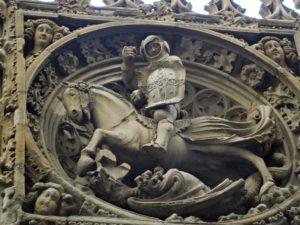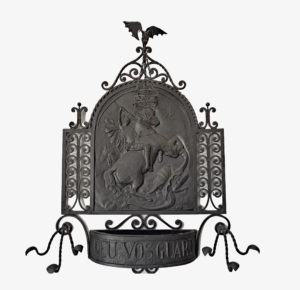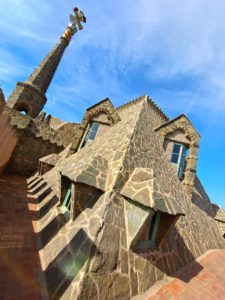- On April 21, 2023
- In A day like today
- Tags: antoni gaudi, april 23rd, barcelona, bellesguard tower, holiday, saint george, saint jordi, torre bellesguard
No Comments
Saint George, a legend made architecture
By: Ferran Garcés
This Sunday is the Feast of Saint George, the most special of our festivities. The Bellesguard Tower is closely related to the legend of Saint George. The devotion to this legend began to take shape in Catalonia during the time of Martin I the Humane, who lived in the medieval castle of Bellesguard between 1409 and 1410. During the five centuries that followed, it took on a leading role in the imaginary and iconography until the time of Antoni Gaudí, who incorporated it into the decoration and structure of the current Bellesguard Tower.
Origins of the tradition
According to tradition, the famous knight was a Roman soldier converted to Christianity who was martyred on 23 April 303 for not renouncing his beliefs. Because of his military origin, his miracles are related to battles and fights such as that of the dragon, a fact that made him the preferred symbol of the nobility and military orders all over Europe (1).However, as Pere Anguera recalls, “it was only in the 14th century that devotion to the saint began in Catalonia”, but, at first, his feast was “exclusive to knights, without the participation of the guilds or the bourgeoisie” (2) This, we recall, was the time of Martin I the Humane king from 1356 to 1410. In the following century, gradually, the festivity became more popular and the best-known artistic works of the warrior saint began to be commissioned in Catalonia, such as the one made by Pere Joan in 1418, to decorate the façade of the Palau de la Generalitat de Catalunya, which overlooks Obispo street (3).

April 23rd was declared a public holiday in the principality of Catalonia in 1436, although it was not until 1456 that it became official. Curiously, the tradition of giving roses as a gift originated in this period, and it was done in the courtyard of the Palace of the Generalitat (4). Again, Pere Anguera reminds us how “the legend of Saint George was translated into Catalan at the end of the 14th or beginning of the 15th century, as well as his presence in several literary works, for example, Curial and Güelfa” (5).Despite such promising origins, the devotion and festivity of Saint George in Catalonia over the next three centuries went through several ups and downs. It would not recover until the end of the 19th century, thanks to Romanticism and the Renaixença. In the 20th century, it gained momentum as it became a Catalan nationalist symbol (4). In a postcard dated 23 April 1907, the year in which Gaudí was building Torre Bellesguard, one of its owners at the time, Francesc de P. Figueras y Sagués, wrote to his eldest daughter, Maria: ‘On the day of St. George’s Day, the patron saint of the Catalans, is the day on which I am 35 years old. Your father who loves you” (6).
Saint George to the work of Gaudí and BellesguardWhat a paradox. Gaudí died in 1926, the year in which the feast of Saint George was joined by a new tradition, that of the Day of the Book, promoted by the publisher Vicent Clavel in Barcelona (7). The same city that the modernist architect nourished with so many symbols related to the legend of Saint George and the Dragon, and which, in recent years, has inspired so many books inspired by them. Unfortunately, the dragons of Torre Bellesguard are still not sufficiently well known. Help us to make them known. The first one can be found at the hanger in the lobby, just at the entrance of the tower.

Now look at the next picture. It corresponds to one of the corners of the small board on the terrace. Can’t you see the nose, the eyes, the scales, and the back of the dragon? Take a closer look. Behind this head, we can see a pinnacle representing the knight’s lance, or sword, thrust into the dragon.

In short, as we said at the beginning, Torre Bellesguard is related to the legend of Saint George from the time of the castle of Martin I, when the imagination of this legend took shape, until the time of Gaudí, five centuries later. On the other hand, the medieval atmosphere, which recreates both the garden and the building, makes Torre Bellesguard an ideal place to celebrate the holiday of St. George, and the dragon, both the knight and the beast, are waiting to welcome you! Happy Saint George’s Day!
NOTES
(1) J. L. A.: “Se acerca San Jorge, patrón de Aragón: ¿qué países celebran también su figura?”, Heraldo de Aragón, 22/4/2022. Link.
(2) Anguera, Pere. Sant Jordi, patró de Catalunya, Barcelona, Rafael Dalmau Editor, 2010, pàg. 16
(3) “Sant Jordi en el palau”, web Gencat (la Generalitat de Catalunya), recuperat el 2/04/2023. Link.
(4) Costa, Roger, “Des de quan regalem roses per Sant Jordi?”, Sapiens, recuperat 7/4/2023 Link.
(5) Anguera, Pere. Op. cit., pàg. 17
(6) Figuera i Bas, Josep Mª, La família Figueras. Els senyors de Bellesguard, Barcelona, autoeditat, 2016, pàg. 78
(7) “¿Quién invento el día del libro? Vicente Clavel”, www.diadellibro.eu. Recuperat 7/4/2023. Link.
